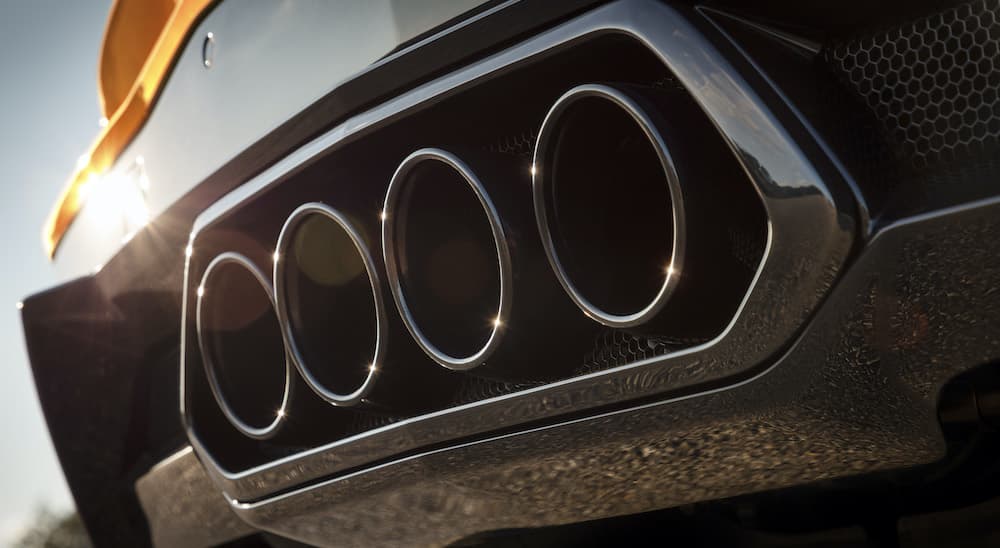Noise surrounds us. It inundates us, isolates us, occasionally overwhelms us completely. Sound can send a shiver down our spines and raise the hairs on the back of our necks. Its absence is suffocating–or completely liberating–and when any one noise speaks loudly enough, we feel it in our bones. Simple pressure waves–pulses of highs and lows, capable of traveling through air, water, and stone–when spaced apart just so, at just the right frequency and intensity, have a power far greater and wider-reaching than any tactile or visual sensation. It is for this reason that car enthusiasts should be grateful for the 2023 Corvette Z06. Whether or not you own one, whether you hear it on the road or at your local Chevy dealer, you will experience its sound.
Sound is an essential component of every automotive design. Those who prefer a V8 to V6 or I4 engines base this opinion not on horsepower or torque–smaller, more efficient engines from today’s market can easily overpower yesterday’s V8s–but on the sound they make, associating the throaty, ragged rumble with muscley swagger. The total absence of sound is a hallmark of electric and luxury vehicles and imparts a transcendent serenity to the drive, while droning transmissions or unmuffled exhausts cause headaches for all. On the other hand, hearing the unearthly scream of F1 race cars or the high-pitched howling of Italian supercars creates an association between sound and performance.
Sound has long been an important part of the Corvette experience as well. From the booming rumble of ’63 thru ’76 Sting Rays (however they spelled it) to the sporty throb of modern Grand Sports and ZR1s, the playlist is long and diverse. 2023 adds a new track and represents a new direction for the brand, an important piece of what makes the new Z06 so rimarchevole.
How Sound Works
Engineering the sound of a vehicle is an incredibly detailed practice, with direct connections to the performance of the powertrain and a dependence on variables so numerous that it’s as much of an art form as a science. It’s worth spending a minute to understand what’s contributing to the sound that we hear from the exhaust pipes.
At its core, the function of an internal combustion engine is to control an explosion. The exhaust note is driven first by these explosions, happening in every cylinder once every 4 (sometimes 2) strokes of the piston. Each explosion creates one bang or one pressure pulse. There’s no “note” to a single cylinder firing on its own–that requires some filtering of the noise and stringing together a number of explosions in a short time.
A rate of 10 explosions per second matches a frequency of 10 Hz, a very low pitch. A V8 engine fires 4 explosions per crankshaft revolution (a feature inherent to the 4-stroke engine cycle), so a V8 idling at 1000 rpm can be calculated to make a noise of 67 Hz, a slightly lower pitch than most of the deepest speaking voices–but roaring up to 6000 rpm raises that to just over 400 Hz, near the range of a baby’s cry.
The ‘Vette’s Got Pipes!
Wait a second, you might say, a redlining V8 sounds nothing like a crying baby! And you’d be right, of course–that’s just the frequency or pitch of the note. Neither a baby nor a V8 makes pressure waves that follow a perfect sinusoidal curve with flawless, continuous rises and falls–the shape and material composition of the physical objects which make, transmit, or reflect the noise all influence the imperfections that make sound waves uneven and ragged, imparting a unique tone and timbre to all. Ever hear somebody say, “That singer’s got pipes!” or something of that nature? They’re referring to the combination of the windpipe, vocal chord, and other airways through which the sound of their voice is made; for an automobile, that’s the exhaust pipes.
Every detail matters here. The material and dimensions of the exhaust pipes, every bend in the lines, the length of the pipe from each cylinder to the point where it joins the main exhaust line, the firing order of the cylinders, the construction of the catalytic converter, muffler, and (if present) resonator(s) all contribute to the noise that finally comes out of the tailpipes. Imagine a dragster, with individual exhaust pipes for each cylinder pointing straight up the sky, and the tremendously loud, jagged sound of the unfiltered explosions–with the right pipes, that incredible cacophony could be transformed into a trumpeting roar.
Mufflers and resonators primarily function to filter out parts of the noise that people don’t want to hear, frequencies identified as harsh and unpleasant. With porous sidewalls and carefully constructed chambers filled with reflecting surfaces, these are the most important components of the exhaust from a sound perspective. Similar to the way that glass windows let sunlight pass through, but not infrared “heat” waves, or how sunglasses block light based on its polarity, the muffler and resonator are built to trap and cancel out specific frequencies while longer and shorter wavelengths can pass through unaffected. Careful design choices–and no small amount of experimentation–in each of these features leads to the finished product of the exhaust note.
Crafting the Song of the Z06
The C8 Corvette represents a significant departure from past Corvette design–it is finally the mid-engine sports car that it always aspired to be. The 2023 Z06 features an all-new engine as well, the most powerful naturally-aspirated V8 ever placed in a production car, with special design features that take performance and sound to a whole other planet from the base Stingray.
At one point during the development of this engine, the Z06 designers realized that the sound wasn’t quite right. So they took the entire exhaust system back to the drawing board and started over, changing the shape and configuration to achieve the desired tone. Then test drivers realized that the car sounded wonderful from the outside but that the quality of sound insulation–and the fact that the engine and exhaust are all behind the driver–meant that the sound didn’t carry to the interior. This was considered a travesty and an unacceptable consequence of the existing design.
So they added non-functional exhaust tips and reworked the rear fascia to mount them. Normally, fake exhaust tips are a pure vanity piece. No impact to the performance or driving experience at all, just a bit of flash for onlookers to ogle at. Therefore one could be forgiven for lamenting the Z06’s inclusion of these fake exhaust tips. However, these tips, which serve no purposes for channeling gases or shaping the exhaust note, are still practically functional–they have a reverse trumpet shape which reflects the sound from the true exhaust tips back towards the front of the car, increasing the volume of the engine noise heard from inside the vehicle!
A True Alto
The classic ragged sound of a rumbling American V8 is the result of a cross-plane crank design, with lobes rotated 90 degrees from each other. This means that while some pistons are at top dead center or bottom dead center, the rest are at the halfway point heading in either direction. This results in a firing order that occasionally sees two cylinders on the same side of the engine fire one after the other, along with other illogical sequences. The distance that each pulse must travel and how it interacts with other pulses along the way before exiting the tailpipe are key to the sound quality, so this off-kilter firing order creates a specific sound distinct to American V8 engines.
The classic Ferrari sound is the result of a flat-plane crank, with lobes 180 degrees from each other and a consistent left-right firing order that leads to a balanced sound. This specific crank design also reduces the rotating mass inside the engine, allowing for quicker acceleration and a higher redline. This is part of why a Ferrari howls while a Mustang roars–even the C7 Corvette redlined at around 6500 rpm, whereas the F430 capped out over 8500 rpm.
As if you don’t already know, I dare you to guess what kind of engine Chevy put in the new Z06. The new LT6 is a 5.5L flat-plane crank V8 with an astronomical 8600 rpm redline, which–if you remember the bit of math that I threw out earlier–puts the peak pitch at 573 Hz, a D5 squarely in the middle of the classic alto range, just like the Ferrari. Listening to early audio recordings, the portamento of the gradually accelerating engine gave me goosebumps, and when comparing the Z06’s song directly to a racing F430, I can’t tell the difference. Could you ask for anything more from the ultimate American sports car?
A World-Class Aural Experience
The Corvette has often been called the “poor man’s Ferrari” through the years, with styling and performance that has aspired to reach far beyond its price point. The 2023 C8 Z06 takes performance that was already on par with comparable Ferraris, at prices that are obviously far more accessible, and ratchets it up another notch while also creating a sound experience that can only be described as spiritual. I’d dare opine that it’s now more appropriate to call Ferrari the “rich man’s Corvette” because it sure seems to me that in nearly every respect, today it is Chevy who is setting the standard.






